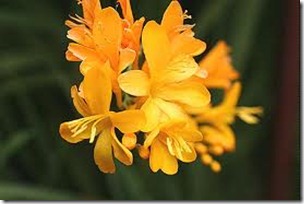The bright-red flowers of the crocosmia plant bloom for several weeks in the summer. The plants, native to South Africa, are members of the iris family. In Africa, they primarily grow in or near the forests. Hybrids of crocosmia produce yellow or orange flowers, offering a range suitable for many gardens. The plants attract wildlife, especially birds that eat its seeds. The flowers make a good fresh-cut bloom for bringing indoors to enjoy.
Description
-
Crocosmia, also known as Coppertip or Falling Stars, grows from 35 to 40 inches in height with a spread of about 6 inches. The plant produces brightly colored, funnel-shaped flowers that appear on spiked, arching stems and long, sword-shaped leaves resembling iris leaves. Crocosmia forms good-sized clumps and spreads easily on its own.
Planting
-
The plants grow in U.S. Department of Agriculture Plant Hardiness Zones 6 to 10, but require protection if temperatures fall below 28 degrees. To grow crocosmia, plant corms several inches apart at a depth of about 5 inches in a sunny area of the garden, preferably in a south-facing location. The best time to plant the corms is in the spring when the threat of frost passes.
Care
-
While crocosmia tolerates drought, the plants require regular watering during the growing season. If you live in a warmer region, leave the corms in the ground all winter. In cold regions where freezing weather occurs often, dig up the corms and store them in a cool location from late fall through winter. The plant’s ability to easily spread means it requires dividing every few years to keep the plants healthy. If crocosmia becomes overcrowded, it stops blooming. Before winter sets in, a few inches of mulch helps the plants survive the winter if left in the ground.
Cultivars
-
Gardeners may choose from a variety of cultivars, including Lucifer with its bright-red flowers. For apricot-colored blossoms, Crocosmia crocosmiiflora makes a good choice with the added benefit of bronze foliage in the fall on plants that reach up to 4 feet in height. For late summer color, C. masonorum produces red flowers on dark green foliage. One of the taller cultivars, C. paniculata, features deep orange flowers on plants reaching up to 6 feet in height. Another cultivar, C. aurea, thrives along stream banks and other moist areas, producing golden-orange flowers. The cultivar, Montbretia, resembles a small gladiolus plant until it blooms in late summer with orange, gold or yellow flowers shaped like stars.


Deprecated: strpos(): Passing null to parameter #1 ($haystack) of type string is deprecated in /home/agriviek8Qv/agriviet.net/public_html/wp-includes/comment-template.php on line 2522